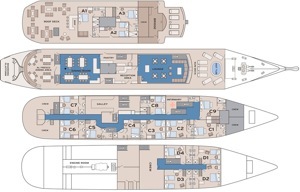
The Galapagos
Exploring in Depth Aboard the Evolution
10-Day Expedition Voyage
November 14 – 23, 2008

$4498 Per Person D1,2,3,4 & C4,5
$4698 Per Person C1,2,3,6,7,8,9
$4898 Per Person A2&A3
$5198 Per Person A1
Plus International Air
Plus In country Airfare Guayaquil/Galapagos/Guayaquil Starting $390
*Single Supplement $1568
Reservation Form is available at the end of the itinerary.
Chances are, if you’re interested in nature and wildlife you’ve always wanted to visit the Galapagos Islands ... a dream of so many adventurous travelers. Straddling the equator in the Pacific Ocean, these islands are home to some of the most interesting and accessible wildlife anywhere. You’ll find yourself just inches away from giant tortoises and the courtship rituals of comical blue-footed boobies, and you’ll gain an appreciation for how remarkable life on Earth can be.
The animals of the Galapagos Islands have adapted to such unusual conditions that they have become a living study of evolutionary science. And since the islands are so isolated and have few natural predators, the wildlife has very little fear of humans, allowing you to get unbelievably close.
On our 10-day voyage you’ll have ample time to explore the islands’ diverse terrain — desert landscapes, lush highland forests, volcanic soils and nutrient-rich waters. We’ll visit Fernandina Island, where earlier this year a small volcano erupted, and see how the animals are adapting to this change — evolution before your eyes. There will be plenty of time to snorkel alongside sea lions, or relax in the clear waters of the Pacific.
We sail aboard the 32-guest M/V Evolution, the perfect size and the perfect way to explore. This ship, just refurbished, is crafted in the manner of a historic European steamer, capturing the spirit and style of an earlier era. During your voyage you will be accompanied by outstanding naturalist guides who are not only authorities on the wildlife of the Galapagos Islands, but also are a pleasure to be with. They will see that you get the most of your experience.
Kitty Coley is the perfect naturalist to help you explore this unique archipelago as she has led more than 20 expedetions throughout the Galápagos and has been diving, snorkeling and hiking throughout the islands since 2001. Trained as a geologist, Kitty's knowledge of volcanoes combined with her love of nature and ornithology make her ideally suited to introduce you or your family to the volcanoes, birds, and marine mammals of these remarkable islands. She is an enthusiastic teacher who will share her great love of nature, geology, and the wildlife of these magical islands. Kitty shares her knowledge through both entertaining presentations, and impromptu discussions on walks and while deckside. She prides herself on making information understandable to any age group.
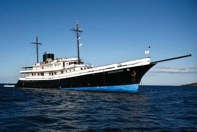
Day 1 • Friday
Miami / Guayaquil
Our expedition begins in the Miami International Airport, where we check in for our early evening flight to Guayaquil, Ecuador. On arrival, our representatives meet us and take us to our fine hotel for the night. (Meals Aloft)
(Evolution - © Sabastian Crespo / International Expeditions)
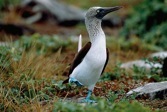
Day 2 • Saturday
Guayaquil / San Cristóbal / Cerro Brujo
After breakfast at our hotel, we transfer to the airport and fly to the Galapagos Islands. Our crew meets us at San Cristóbal Island and escorts us on the short bus trip to the harbor, where our 32-guest expedition ship, the M/V Evolution, awaits us. This afternoon we visit the powder-white sands of Cerro Brujo for swimming and snorkeling, with a good chance of sea lions joining us. We'll likely see blue-footed boobies, yellow warblers and finches. (B,L,D) Blue-footed booby
© Greg Greer / International Expedition
Day 3 • Sunday
Española (Hood) Island: Punta Suarez and Gardner Bay
In the morning we visit Punta Suarez, also located on Hood Island, where we wade ashore through a large sea lion colony. The curious Hood mockingbird, found only here, may alight on your head if you permit it. We’ll

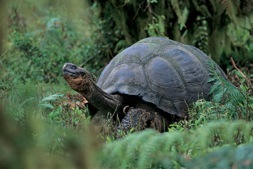
Santa Cruz Island
Today we visit Santa Cruz Island. We begin at the Charles Darwin Research Station, world famous for its research and tortoise breeding programs, where we learn about the vital work being done to study and preserve Galapagos wildlife. We walk to the village of Puerto Ayora, the largest human settlement in the Galapagos, with free time to explore.
Then we drive to the highlands and see a very different side of the Galapagos: the forested highlands. We look for giant tortoises in the wild, and walk through the forest surrounding a pair of pit craters, and time permitting explore a lava tube. (B,L,D) Giant Tortoise - © Mason Fischer / International Expedition
Day 5 • Tuesday
Santiago (James) Island / Bartolomé Island
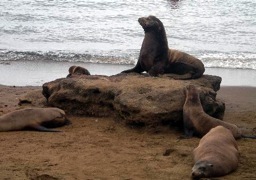
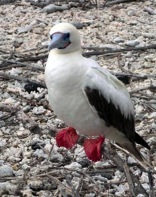
Genovesa (Tower) Island / Darwin Bay
Genovesa Island contains one of the largest and most diverse bird populations in the Galapagos. From our pangas we see red-billed tropicbirds. In the morning, we climb Prince Philip’s Steps to an area with colonies of Nazca boobies and great frigatebirds, which have a very large wingspan and a slender, dramatic silhouette in flight. Breeding males inflate their strawberry-colored chest pouches to an enormous size. There are also red-footed boobies and the subtly-colored Galapagos dove, once endangered but now increasing in number. In the afternoon we visit Darwin Bay, home to the nocturnal swallow-tailed gull and the rare lava gull. A walk along the cliffs gives us fine views of the Pacific Ocean. We have a chance to swim and snorkel here. (B,L,D)
Day 7 • Thursday
Fernandina Island – Punta Espinosa / Isabela Island - Tagus Cove
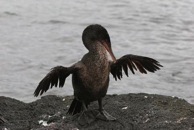
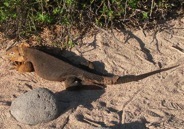
In the morning we visit North Seymour Island, where there are good nesting sites for a large population of magnificent frigatebirds. Blue-footed boobies perform their courtship dance in the more open areas, and swallow-tailed gulls perch on the cliff edges. Despite the surf that can pound the outer shore, sea lions haul out onto the beach and can be found along with marine iguanas. Caleta Tortuga Negra (“Black Turtle Cove”) is a beautiful and peaceful area of mangroves, where on our panga ride we look for schools of golden rays, endangered green sea turtles, white-tipped reef sharks, lava herons and blue-footed boobies. For part of the time, we’ll turn off the motors of our pangas and just drift silently through the cove.
Day 9 • Saturday
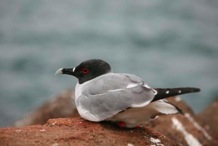
Kicker Rock / San Cristóbal / Guayaquil
The morning we sail out to Kicker Rock, which rises 500 feet straight up, and has the shape of a sleeping lion. We enjoy a “panga” (small boat) ride, seeing the thousands of seabirds which nest here, including blue-footed boobies, Nazca boobies and swallow-tailed gulls. Back at San Cristóbal, we visit the Interpretation Center to learn about conservation efforts in the Galapagos. We then fly to Guayaquil, where we enjoy a farewell dinner at our hotel. (B,L Aloft,D)
Day 10 • Sunday
Guayaquil / Miami
We take a morning flight to Miami, and connect with flights home. (B,L Aloft)

-
• M/V Evolution details:
-
• 192’ long
-
• Registered in Ecuador
-
• Built in 1975, refurbished in 2003
-
• 16 spacious cabins, 32 guests
-
• Public spaces include an observations deck, sun deck,
hot tub, library/lounge, canopied bar.
-
• Snorkeling equipment, wet suits and kayaks are available
at no cost to guests

Pricing for the 10-day Galapagos Expedition based on double occupancy includes:
-
• Land and air arrangements from hometown for Kitty Coley as tour host based on 15 full paying guests..
-
• Hotels, meals and activities as described in the detailed itinerary.
-
• Outstanding professional naturalist guides.
-
• Excellent accommodations aboard a 32-guest yacht – the Evolution.
-
• Meet and greet in Miami to assist with check in.
Items not included in the price:
-
• Round trip transportation from home town to Miami.
-
• Round trip air transportation from Miami to Ecuador, priced separately. $50 ticketing fee will apply
-
• In country airfare Guayaquil/Galapagos/Guayaquil, priced separately.
-
• U.S. and Ecuador airport departure taxes and fuel surcharges.
-
• Passports, beverages from the bar, laundry and other personal items.
-
• Gratuities to the naturalist guides, captain and crew
We have only 15 spaces reserved on this Expedition so hold your place now with a deposit of only $39, applicable to the cost of the trip. See the reservation form for more information on this initial and future deposits.
Download the Reservation Form for the Galapagos here:
Galapagos Reservation Form.pdf.
If you are having trouble printing the itinerary, try this printer-friendly version:

Here are a few of Kitty’s pictures from her last trip to the Galapagos:
Kitty Coley Expeditions
